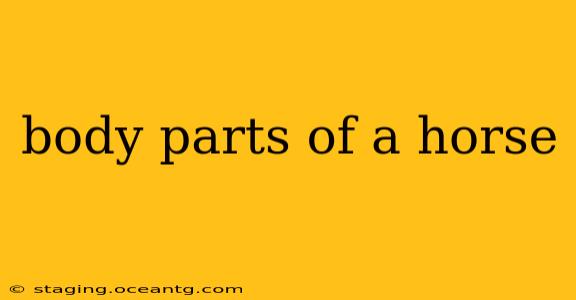Understanding the anatomy of a horse is crucial for anyone involved in their care, riding, or simply appreciating these magnificent animals. From the elegant curve of their neck to the powerful muscles of their hindquarters, each part plays a vital role in their overall health and performance. This comprehensive guide will explore the major body parts of a horse, offering insights into their function and importance.
Head and Neck
The horse's head is striking, featuring expressive eyes and sensitive ears. Let's break down some key features:
- Muzzle: The moist, sensitive area encompassing the nostrils and lips. Essential for grazing and breathing.
- Nostrils (Nares): Large, flaring nostrils allowing for efficient respiration, particularly during strenuous activity.
- Eyes: Large and positioned laterally, providing a wide field of vision. This allows horses to detect potential predators or obstacles easily.
- Ears: Mobile ears that rotate independently, allowing for precise sound location. Their position often indicates a horse's mood or alertness.
- Forehead (Poll): The area between the ears.
- Neck: A flexible neck allows for efficient grazing, as well as balance and maneuverability while running or jumping. The muscles here are crucial for carrying the weight of the head.
Body
The horse's body is a marvel of power and grace. Key elements include:
- Withers: The highest point on the horse's back, located just behind the neck. A common reference point for measuring height.
- Back: The area from the withers to the loin. Supports the rider's weight and plays a crucial role in locomotion.
- Loin: The short area between the back and the croup. Strong loin muscles are important for athletic performance.
- Croup: The area over the horse's hindquarters, sloping down to the tail.
- Chest: The broad area containing the heart and lungs. A deep chest is desirable, indicating good respiratory capacity.
- Rib Cage: Protects vital organs. Horses with well-developed ribs have more room for the heart and lungs to function efficiently.
- Belly (Abdomen): Contains digestive organs.
Legs and Hooves
The legs of a horse are exceptionally strong and provide stability and power. Let's examine the components:
- Forelegs: Support the majority of the horse's weight.
- Hind legs: Provide the powerful propulsion for movement.
- Shoulder: Connects the foreleg to the body.
- Elbow: Similar in function to a human elbow.
- Knee (Carpus): Corresponds to the human wrist.
- Fetlock: A joint connecting the cannon bone to the pastern.
- Pastern: A short bone connecting the fetlock to the hoof.
- Coffin Bone: The bone inside the hoof.
- Hooves: Protective coverings at the end of each leg, essential for locomotion and shock absorption. Proper hoof care is critical.
Tail
The horse's tail is more than just an elegant appendage. It serves crucial functions including:
- Insect control: The tail acts as a fly swatter, helping to keep insects away.
- Balance: The tail helps maintain balance, particularly during turns or jumps.
- Communication: The tail's position can indicate a horse's mood or state of alert.
What are the different parts of a horse's leg?
As detailed above, a horse's leg is complex and includes the shoulder, elbow, knee (carpus), fetlock, pastern, coffin bone, and hoof. Each part plays a vital role in its stability, strength, and locomotion.
What is the highest point on a horse's back called?
The highest point on a horse's back is called the withers. This is a common reference point used for measuring the height of a horse.
How many legs does a horse have?
A horse has four legs, two forelegs and two hind legs. These legs are crucial for the horse’s movement, balance, and support.
What are the main parts of a horse's head?
The main parts of a horse's head include the muzzle, nostrils, eyes, ears, forehead (poll), and neck. Each part has a vital role in the horse's senses, feeding, and overall health.
This detailed exploration of horse body parts provides a fundamental understanding of their anatomy and function. Remembering these key features is essential for anyone who interacts with horses, contributing to improved care and understanding of these remarkable animals.
